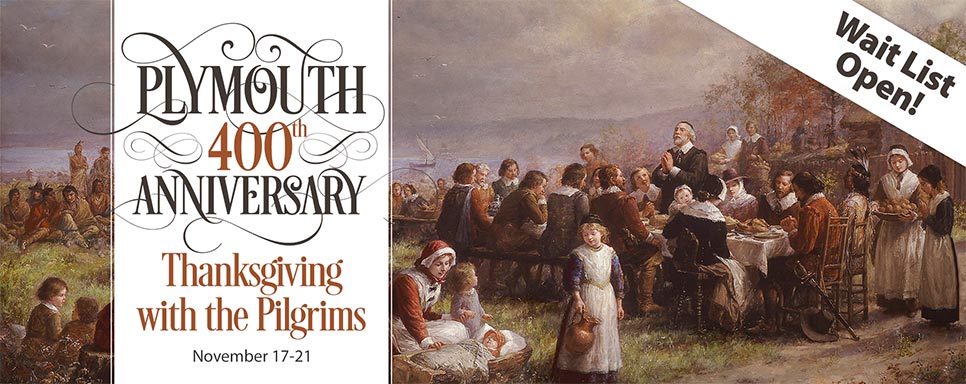
“But he that sins against me wrongs his own soul: all they that hate me love death.” —Proverbs 8:36
Royal Family of Russia Murdered, July 17, 1918
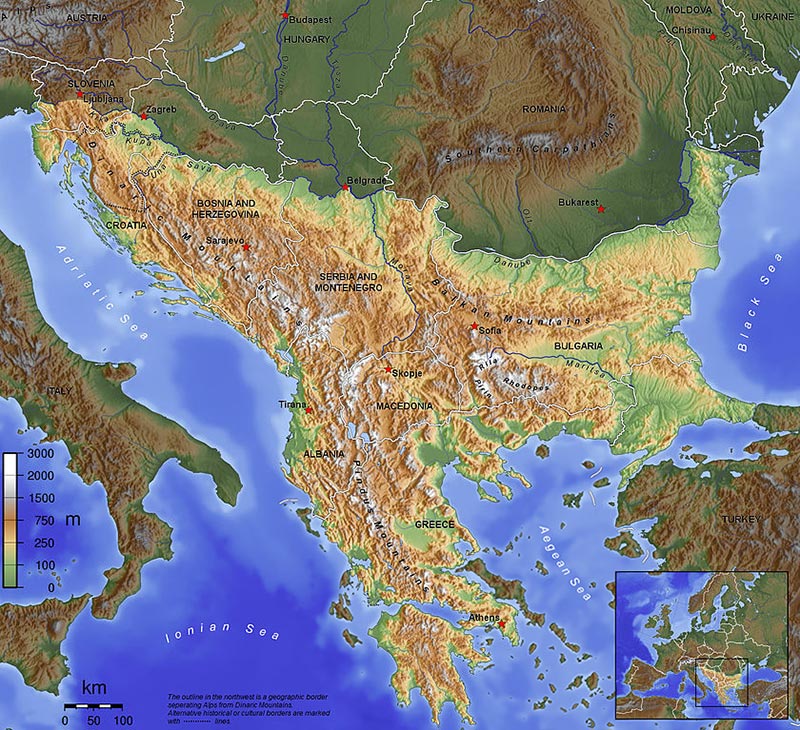
The Balkan peninsula region, loosely defined as fully or partly encompassing: Albania, Bosnia and Herzegovina, Bulgaria, Kososvo, Montenegro, North Macedonia, Croatia, Greece, Serbia, Slovenia and Turkey
|
 sar Nicholas II was the last emperor of “All Russia.” He and his family were arrested during the Bolshevik Revolution which engulfed Russia in 1917. Nicholas and the German Kaiser, Wilhelm, were first cousins and both had tried to get the other to back down from going to war in 1914, when Serbia was attacked by Austria. The “Willy-Nicky” letters, however, did not stop the various pre-war national alliances from rolling forward with military action in the Balkans (“the powder keg of Europe”), and snowballing until all of Europe was aflame. Russia was not prepared for the German onslaught that swept into their territory, eventually killing more than a million and a half Russians and capturing more than a million more. The Tsar remained at the front, while his empire disintegrated behind him, with millions of Russians tired of the losses from the war and ready to be led into a totally new kind of political regime. Nicholas finally returned home, too late to stop the revolution. sar Nicholas II was the last emperor of “All Russia.” He and his family were arrested during the Bolshevik Revolution which engulfed Russia in 1917. Nicholas and the German Kaiser, Wilhelm, were first cousins and both had tried to get the other to back down from going to war in 1914, when Serbia was attacked by Austria. The “Willy-Nicky” letters, however, did not stop the various pre-war national alliances from rolling forward with military action in the Balkans (“the powder keg of Europe”), and snowballing until all of Europe was aflame. Russia was not prepared for the German onslaught that swept into their territory, eventually killing more than a million and a half Russians and capturing more than a million more. The Tsar remained at the front, while his empire disintegrated behind him, with millions of Russians tired of the losses from the war and ready to be led into a totally new kind of political regime. Nicholas finally returned home, too late to stop the revolution.
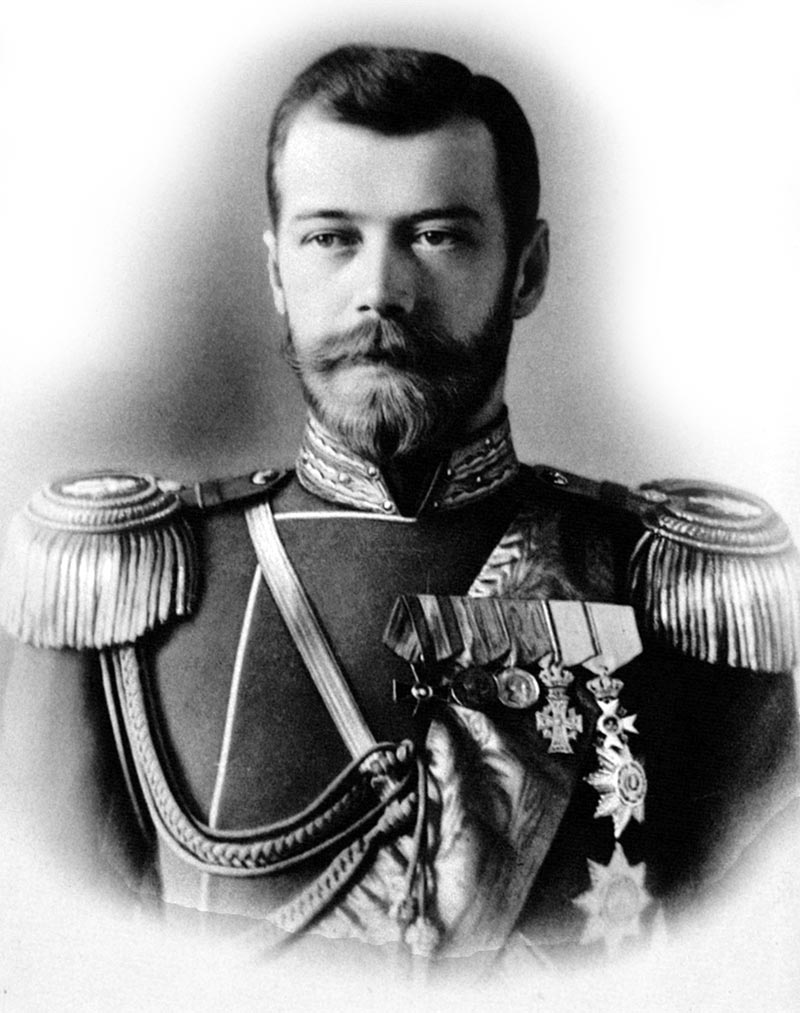
Tsar Nicholas (1868-1918) of Russia in 1898
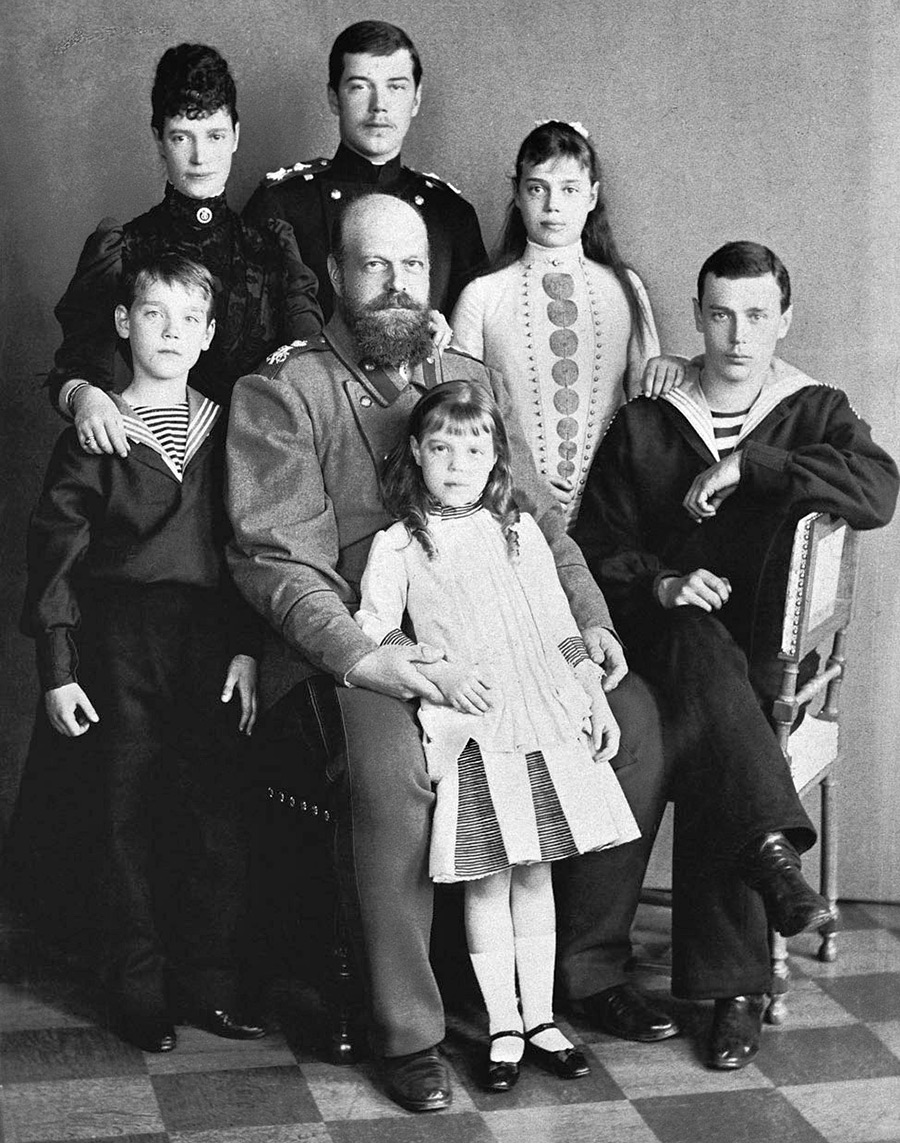
Alexander III (1845-1894) and family, Nicholas his oldest child standing in the center back
|
Nicholas Romanov, born in the Royal Palace in 1868 to Tsar Alexander III, inherited the Russian Empire in 1894 at the age of twenty-six, upon the unexpected death of his father. He was related to many of the royal families of Europe, first cousin to the King of England and Kaiser Wilhelm of Germany. He married the granddaughter of Queen Victoria of England. Together they had five children, the last being Alexei, a hemophiliac and heir apparent.
On the surface, it appeared that, even though Nicholas believed himself God’s representative on earth to rule Russia, and eschewed any thoughts of a constitutional monarchy such as that of his cousins in England, the people of his Empire seemed quiescent enough that his following his father’s policies suited the society well. His foreign policy kept the peace in the Balkans and alliance with France intact, although an ill-advised war with Japan in 1902 proved militarily disastrous, and demonstrated Russia’s real weaknesses.

Tsar Nicholas of Russia
(1868-1918)
|
|
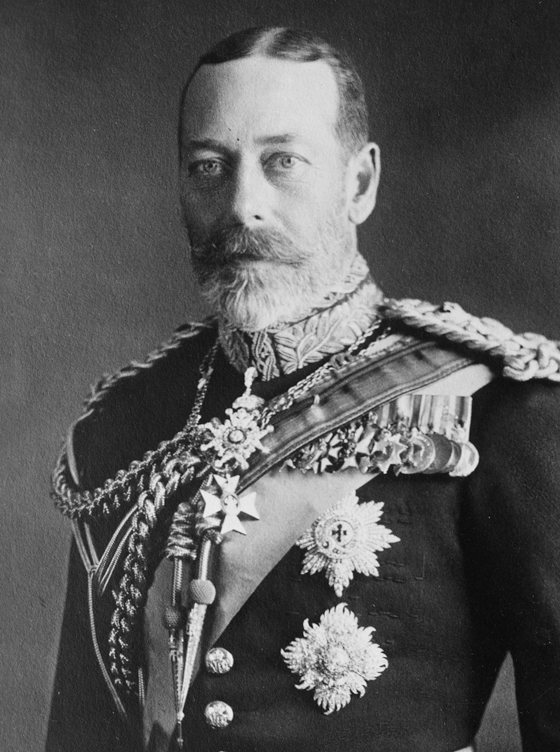
King George V of England
(1865-1936)
|
|
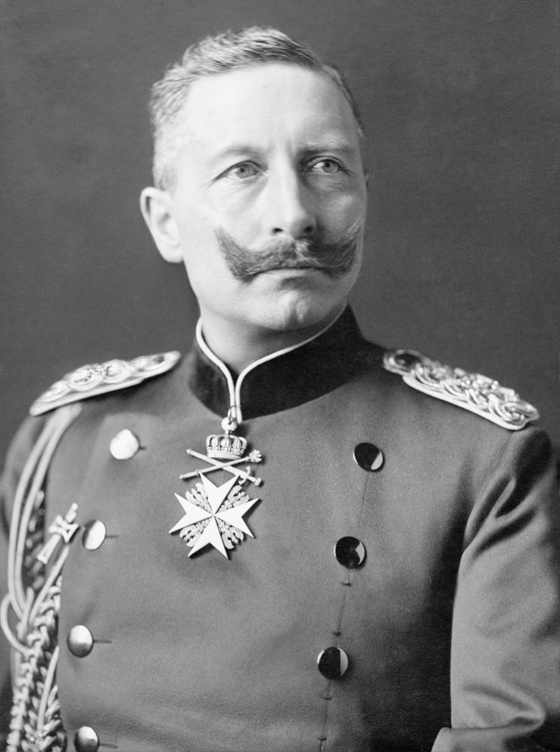
Kaiser Wilhelm of Germany
(1859-1941)
|
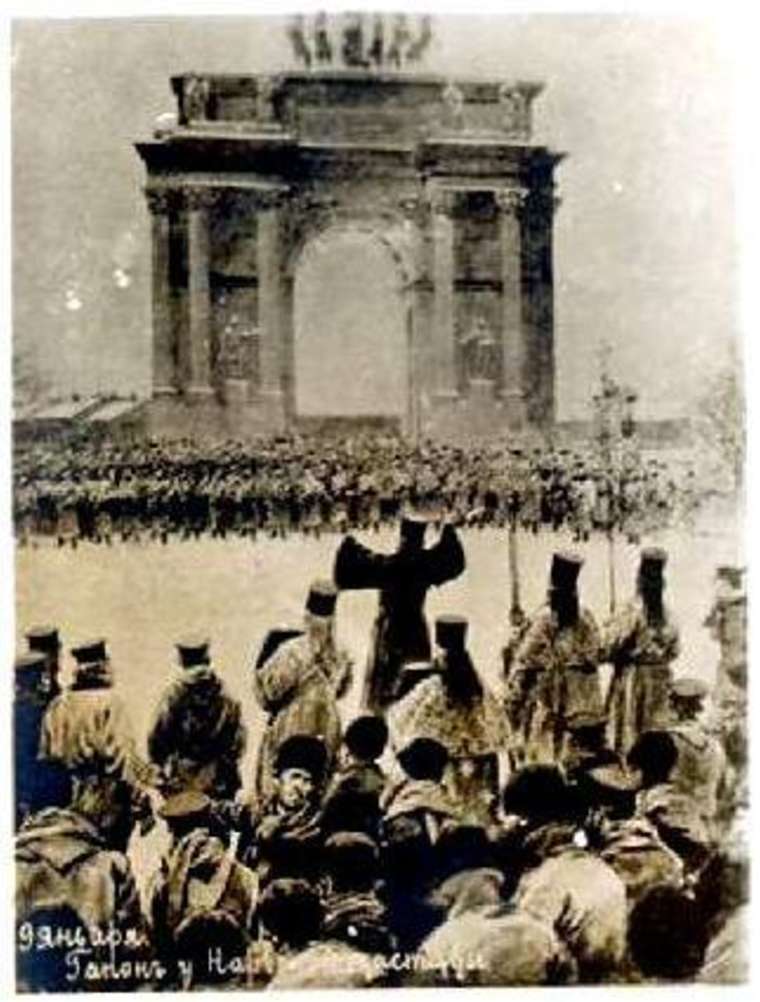
“Bloody Sunday” or “Red Sunday”, January 22, 1905—Soldiers of the Imperial Guard fired upon unarmed demonstrators led by Father Georgy Gapon as they marched towards the Winter Palace to present a petition to Tsar Nicholas II
|
A revolution broke out in 1905 when various workers’ socialist parties marched, unarmed, on the Winter Palace, to present a petition to the Tsar for labor reform. The marchers were essentially peaceful, singing hymns and carrying pictures of the Tsar. Convinced by his counsellors that the marchers were an absolute threat to his autocratic rule, he left St. Petersburg, and the army fired on the demonstrators, killing many. The state “advisory” legislature the Tsar had called into being, the Duma, demanded universal suffrage, radical land reform, and release of political prisoners. The Tsar dismissed the Duma. Workers’ strikes swept the country. By 1911, the third Duma was chosen and moved more strategically in seeking reforms. Three years later doom descended on Europe.
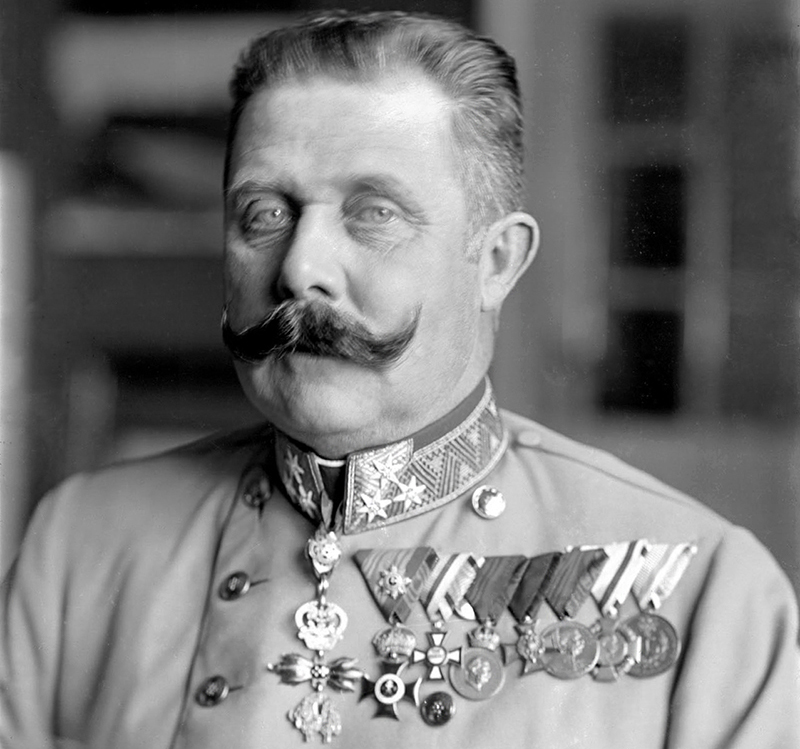
The assassination in Sarajevo of Archduke of Austria Franz Ferdinand (1863-1914) helped precipitate the start of WWI
|
Siding with Serbia over a controversy with Austria—the assassination of the Archduke Francis Ferdinand—Russia went to war with Germany the first week of August, 1914. Although Tsar Nicholas had called for general mobilization, Russia was woefully unprepared to fight a war. Germany had been preparing for more than twenty years for just such a conflict and the ill-advised Tsar sent millions of men to their deaths, some having drilled with broomsticks, and others with no ammunition when sent to battle.

Vladimir Lenin (1870-1924)
|
Food and fuel shortages brought mass starvation to the families at home, as Russian armies reeled before the German attacks. The Duma criticized the Tsar’s attempt to bolster the army by going to the front himself. He dissolved the Duma once again, and political moderates seeking reform joined the more radical parties who were calling for the overthrow of the Tsar. In February of 1917, revolution broke out again when industrial workers struck and hungry people marched calling for bread. Soldiers were called out and fighting in the streets erupted. The Duma formed a provisional government and the Tsar abdicated. In October, Vladimir Lenin and the Bolshevik Party overthrew the provisional liberal “capitalist middle class” Kerensky government, and declared rule by councils of soldiers, peasants, and workers—“soviets.” The Atheistic Bolsheviks, led by Lenin, took over St. Petersburg (renamed Petrograd and later Leningrad). Civil war erupted between the “Whites”—a loose coalition of monarchists, capitalists, and social democrats—and the “Reds,”—the radical communists, which included support from most of the army. The war lasted for about five years, with the ultimate triumph of the Bolsheviks and the establishment of the “Union of Soviet Socialist Republics.”
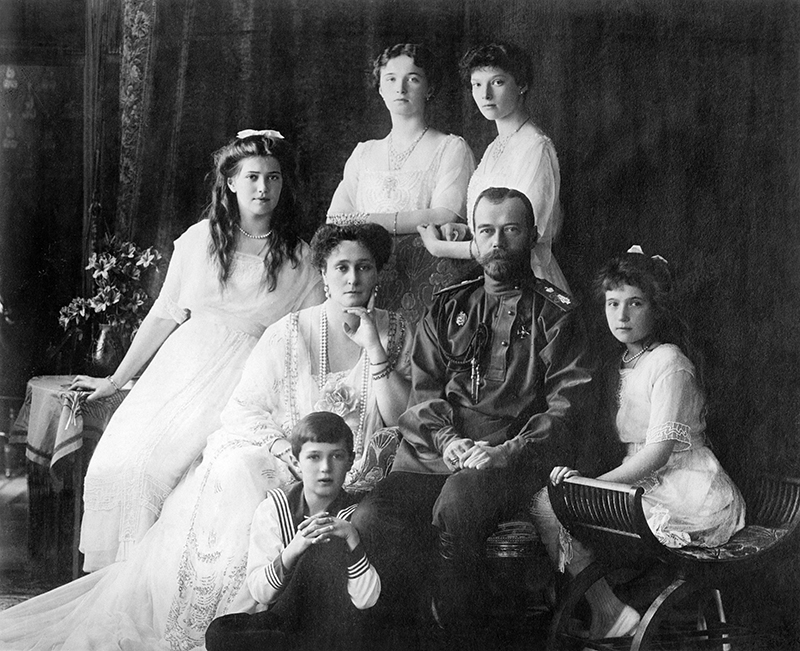
The family of Tsar Nicholas II
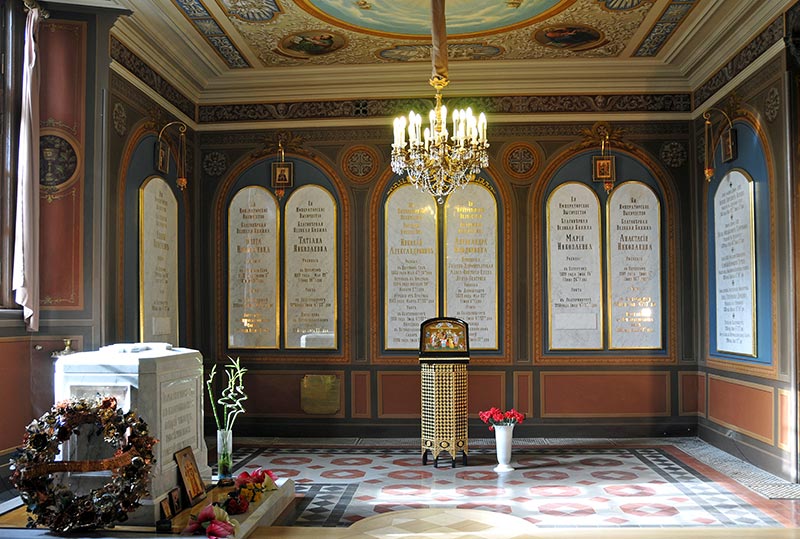
In 1998, 80 years after the executions, the remains of the Romanov family were reinterred in a state funeral at St. Catherine’s Chapel in Peter and Paul Cathedral in St. Petersburg, their final resting place
|
The Royal family was moved several times by the Bolsheviks, finally to Yekaterinburg. On July 17, 1918, the Tsar and his family, whose ancestors had ruled Russia for centuries, were taken to a basement and massacred by the secret police. In 1979, 1998 and 2007, the bones of the Romanovs were discovered in three separate locations, not far from the site of their assassinations, accounting for the entire family and others who were slaughtered with them. Communism demonstrated for the world to see, not just this once, but over and over and over again, what people can expect from the attempt to establish a socialist utopia, whether in Russia, Cuba, China, Albania, Cambodia, North Korea, etc., in a revolutionary world of depraved sinners who rule without God or His Law.

Image Credits:
1 The Balkans (Wikipedia.org)
2 Tsar Nicholas II, #1 (Wikipedia.org)
3 Alexander III and family (Wikipedia.org)
4 Tsar Nicholas II, #2 (Wikipedia.org)
5 King George V (Wikipedia.org)
6 Kaiser Wilhelm of Germany (Wikipedia.org)
7 Bloody Sunday, 1905 (Wikipedia.org)
8 Archduke Franz Ferdinand of Austria (Wikipedia.org)
9 Vladimir Lenin (Wikipedia.org)
10 Royal family (Wikipedia.org)
11 Peter and Paul Cathedral (Wikipedia.org)
|







